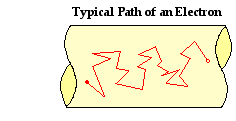Do electrons only bump with other electrons in a circuit and that only causes resistance? Or do they bump with the nucleus as well?
Here's a post I have been studying recently:
The path of a typical electron through a wire could be described as a rather chaotic, zigzag path characterized by collisions with fixed atoms. Each collision results in a change in direction of the electron. Yet because of collisions with atoms in the solid network of the metal conductor, there are two steps backwards for every three steps forward.
Does this mean that electrical resistance originates from the electrons' collisions with nuclei as well as other electrons, or just with other electrons?

